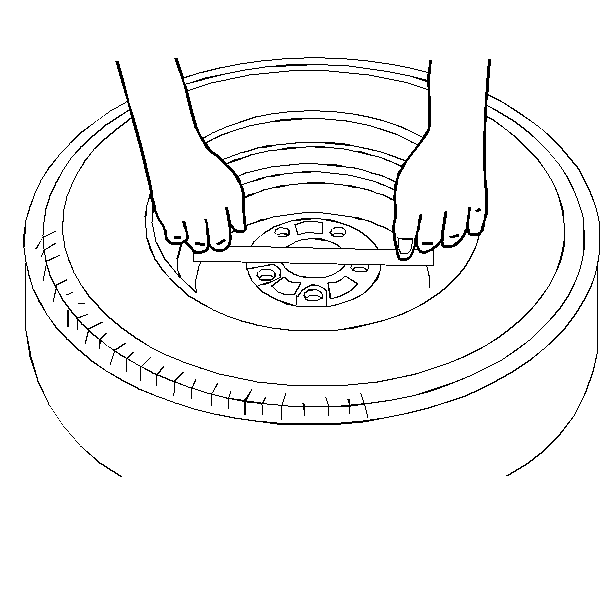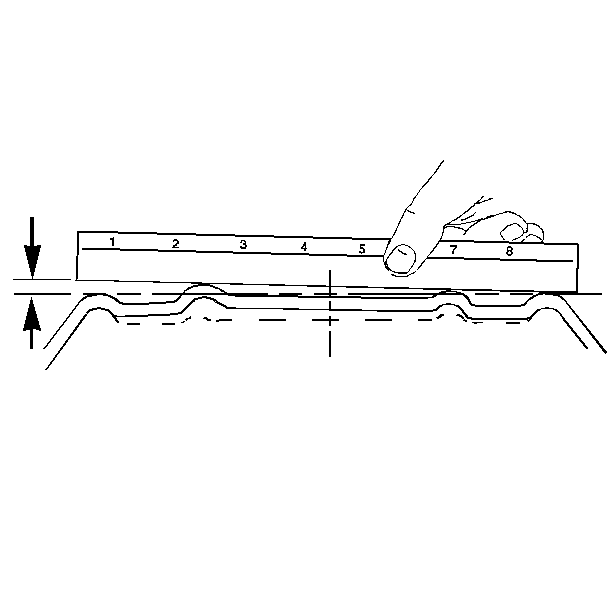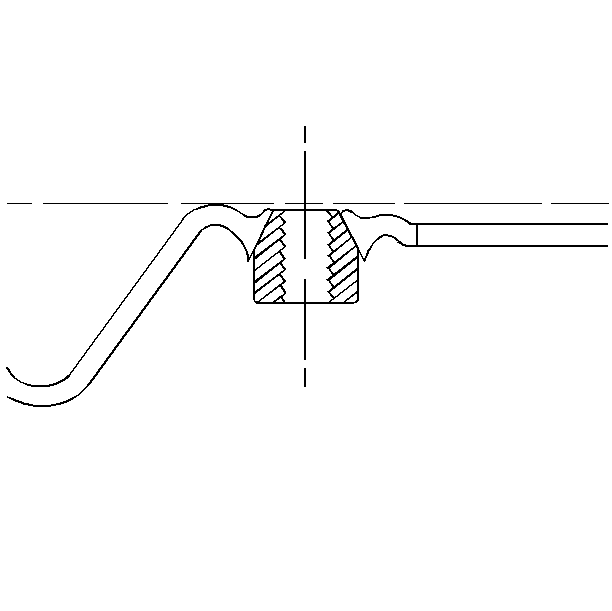Wheel Mounting Surface Check Dual Ring Steel Wheel
Caution: Do Not use flat mount wheels on dual ring type wheel applications. The use of flat mount wheels on a dual ring application may cause the wheel to loosen and could cause loss of vehicle control resulting in personal injury.
Replace any wheels that are bent or dented, or have excessive lateral or radial runout. Wheels with runout greater than specified may cause objectionable vibrations.
- Use a straight edge 203-229 mm (8-9 in) long. Place the straight edge on the wheel inboard mounting surface. Try to rock the straightedge up and down within the mounting surface.
- Repeat this procedure on at least 3-4 different positions on the inboard mounting surface.
- Inspect the mounting wheel/nut holes for damage caused from over-torquing the wheel/nuts. Inspect for collapsed wheel/nut bosses. Inspect for cracked wheel bosses.
- Replace the wheel if the wheel is bent.
- Replace the wheel if the wheel/nut boss area is cracked.


| • | The outer ring of the mounting surface normally is raised above everything inside the mounting surface. |
| • | The mounting surface will be raised above the outer ring if the wheel mounting surface has been bent on a tire changer. |
| • | If you can rock the straight edge, the mounting surface is bent and you must replace the wheel. |

Notice: The use of non-GM original equipment wheels may cause:
• Damage to the wheel bearing, the wheel fasteners and the wheel • Tire damage caused by the modified clearance to the adjacent vehicle
components • Adverse vehicle steering stability caused by the modified
scrub radius • Damage to the vehicle caused by the modified ground clearance • Speedometer and odometer inaccuracy
Important:
• Replacement wheels must be equivalent to the original equipment wheels
in the following ways: - The load capacity - The wheel diameter - The rim width - The wheel offset - The mounting configuration • A wheel of the incorrect size or type may affect the following conditions: - Wheel and hub-bearing life - Brake cooling - Speedometer/odometer calibration - Vehicle ground clearance - Tire clearance to the body and the chassis
Identify steel wheels with a 2 or 3-letter code stamped into the rim near the valve stem.
Wheel Mounting Surface Check Flat Mount Aluminum Wheel
Caution: Do Not use flat mount wheels on dual ring type wheel applications. The use of flat mount wheels on a dual ring application may cause the wheel to loosen and could cause loss of vehicle control resulting in personal injury.
Replace any wheels that are bent or dented, or have excessive lateral or radial runout. Wheels with runout greater than specified may cause objectionable vibrations.
- Use a straight edge 203-229 mm (8-9 in) long. Place the straight edge on the wheel inboard mounting surface. Try to rock the straightedge up and down within the mounting surface.
- Repeat this procedure on at least 3-4 different positions on the inboard mounting surface.
- Replace the wheel if the wheel is bent.
- Replace the wheel if the wheel/nut boss area is cracked.

| • | If you can rock the straight edge, the mounting surface is bent and you must replace the wheel. |
| • | Inspect the mounting wheel/nut holes for damage caused from over-torquing the wheel/nuts. Inspect for collapsed wheel/nut bosses. Inspect for cracked wheel bosses. |
Notice: The use of non-GM original equipment wheels may cause:
• Damage to the wheel bearing, the wheel fasteners and the wheel • Tire damage caused by the modified clearance to the adjacent vehicle
components • Adverse vehicle steering stability caused by the modified
scrub radius • Damage to the vehicle caused by the modified ground clearance • Speedometer and odometer inaccuracy
Important:
• Replacement wheels must be equivalent to the original equipment wheels
in the following ways: - The load capacity - The wheel diameter - The rim width - The wheel offset - The mounting configuration • A wheel of the incorrect size or type may affect the following conditions: - Wheel and hub-bearing life - Brake cooling - Speedometer/odometer calibration - Vehicle ground clearance - Tire clearance to the body and the chassis
To identify aluminum wheels the code, the part number, and the manufacturer identification cast into the back side of the wheel.
